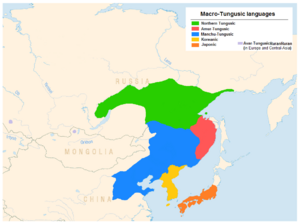Social:Macro-Tungusic
| Macro-Tungusic | |
|---|---|
| (proposed language family) | |
| Geographic distribution | East and Siberia |
| Linguistic classification | One of the world's primary language families |
| Subdivisions | |
| Glottolog | None |
 Language area of the macro-tungusic languages before the migration of the northern-tungusic languages into siberia.
Korean
Japanese
Manchurian
Amur-Tungusic
Northern-Tungusic | |
Macro-Tungusic (also Northeast-Asiatic) is a proposed language family in East Asia and Siberia.
Macro-Tungusic includes the Tungusic languages, the Korean language and the Japanese language. Several linguists, especially James Marshall Unger (1960), Alexander Vovin (2001) and Lars Johanson (2010), show strong similarities between Tungusic, Korean and Japanese and belife that they have a common genetic origin. The proposed Urheimat is located in today Manchuria, along the Amur river.[1][2][3][4]
The relation between Korean and Japanese is mostly accepted. The relation to the Tungusic languages is plausible and supported by several linguists.[5] Mostly all supporters of this theory are against a relation with the Altaic languages (Turkic and Mongolic) and dismiss the controversial similarities as language contact.[6][7][8]
The components of the Macro-Tungusic languages
- Macro-Tungusic
- Buyeo languages
- Koreanic languages
- Japonic languages
- Japanese language
- Ryukyuan languages
- Tungusic languages
- Northern-Tungusic
- Southern-Tungusic (Amur Tungusic)
- Southwest-Tungusic (Manchu language)
- Ruanruan language (?)[9]
- Buyeo languages
Arguments
All three language families show identical grammar and honorifics. Other similarities are:[10][11][12]
- all three languages are agglutinative,
- follow the SOV order,
- nouns and adjectives follow the same syntax,
- particles are post-positional,
- modifiers always precede modified words.
The phonology and the language syntax of Tungusic, Korean and Japanese are very similar and all three languages share some basic vocabulary.[13][14]
Historic information
Ancient chinese chronics say the Tungusic languages are most similar with the languages of Goguryeo, Silla and Japan but they are not completelly the same.[15] The Tungusic language of the Mohe people was most similar to the Sillan language and fast to learn for Japanese.[16]
References
- ↑ Martine Robbeets. "Book Reviews 161 Andrej L. Malchukov and Lindsay J. Whaley (eds.), Recent advances in Tungusic linguistics (Turcologica 89). Wiesbaden: Harrassowitz, 2012. vi + 277 pages, ISBN:978-3-447-06532-0, EUR 68" (PDF). Retrieved 25 Nov2016.
- ↑ "James Unger" (in en). Department of East Asian Languages and Literature. 2011-11-21. https://deall.osu.edu/people/unger.26.
- ↑ Beckwith, Christopher (2007-05-28) (in en). Koguryo: The Language of Japan’s Continental Relatives: An Introduction to the Historical-Comparative Study of the Japanese-Koguryoic Languages, with a Preliminary Description of Archaic Northeastern Middle Chinese. Second Edition. BRILL. ISBN 9789047420286. https://books.google.at/books?id=XeSvCQAAQBAJ&pg=PA233&lpg=PA233&dq=macro+tungusic+theory&source=bl&ots=0waWzVU7sm&sig=dGzSdYn05V9SqAs39kBw4yfllbA&hl=de&sa=X&ved=2ahUKEwjd2tDxwKHdAhVjF8AKHaT0Dw8Q6AEwAHoECAoQAQ#v=onepage&q=macro%20tungusic%20theory&f=false.
- ↑ Vovin, Alexander. 2001. "Japanese, Korean, and Tungusic: evidence for genetic relationship from verbal morphology." Altaic Affinities (Proceedings of the 40th Meeting of PIAC, Provo, Utah, 1997), edited by David B. Honey and David C. Wright, 83–202. Indiana University, Research Institute for Inner Asian Studies.
- ↑ Beckwith, Christopher I. (2004-01-01) (in en). Koguryo, the Language of Japan's Continental Relatives: An Introduction to the Historical-Comparative Study of the Japanese Koguryoic Languages with a Preliminary Description of Archaic Northeastern Middle Chinese. BRILL. ISBN 9004139494. https://books.google.at/books?id=FgaUF46o1UQC&pg=PA27&lpg=PA27&dq=japanese+goguryeo&source=bl&ots=qz03oWYw7r&sig=_xc1a_Y2PLpr3-or_VHjTHvf0UE&hl=de&sa=X&ved=2ahUKEwio45nntaHdAhUrBMAKHaeDB-U4ChDoATAEegQICBAB#v=onepage&q=japanese%20goguryeo&f=false.
- ↑ "While 'Altaic' is repeated in encyclopedias and handbooks most specialists in these languages no longer believe that the three traditional supposed Altaic groups, Turkic, Mongolian and Tungusic, are related." Lyle Campbell & Mauricio J. Mixco, A Glossary of Historical Linguistics (2007, University of Utah Press), pg. 7.
- ↑ "...[T]his selection of features does not provide good evidence for common descent" and "we can observe convergence rather than divergence between Turkic and Mongolic languages--a pattern than is easily explainable by borrowing and diffusion rather than common descent", Asya Pereltsvaig, Languages of the World, An Introduction (2012, Cambridge) has a good discussion of the Altaic hypothesis (pp. 211-216).
- ↑ Unger, J. Marshall. 1990. "Summary report of the Altaic panel." In Linguistic Change and Reconstruction Methodology, edited by Philip Baldi, 479–482. Berlin – New York: Mouton de Gruyter.
- ↑ Vovin, Alexander. 2010. Once Again on the Ruan-ruan Language. Ötüken’den İstanbul’a Türkçenin 1290 Yılı (720–2010) Sempozyumu From Ötüken to Istanbul, 1290 Years of Turkish (720–2010). 3–5 Aralık 2010, İstanbul / 3–5 December 2010, İstanbul: 1–10.
- ↑ Russell Tomlin, "Basic Word Order: Functional Principles", Croom Helm, London, 1986, page 22
- ↑ Lucien Brown (2008), "CONTRASTS BETWEEN KOREAN AND JAPANESE HONORIFICS" (in German), Rivista degli studi orientali 81 (1/4): pp. 369–385
- ↑ Sohn (2001), p. 29.
- ↑ Vovin, Alexander. 2015. Eskimo Loanwords in Northern Tungusic.
- ↑ Takenobu, Francis-Ratte, Alexander (2016) (in en). Proto-Korean-Japanese: A New Reconstruction of the Common Origin of the Japanese and Korean Languages. https://etd.ohiolink.edu/pg_10?0::NO:10:P10_ETD_SUBID:113782.
- ↑ "Book of the Later Han"
- ↑ (in German) 한중 이견속 발해는 고유문자 있었나, http://www.inews365.com/mobile/article.html?no=158476, retrieved 2018-09-03

